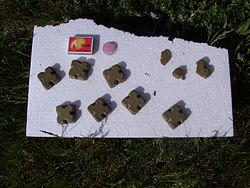- Oral vaccination against rabies
-
Oral vaccination against rabies is a preventive measure to eradicate rabies in wild animals, vectors of disease, mainly foxes and rare raccoons, raccoon dogs, coyotes and jackals, but also can be used for dogs in developing countries[1].
Contents
Baits
Baits used for oral vaccination are made of fishmeal or dog food and contains vaccine packet with V-RG, a recombinant vaccine made from a living pox virus vector, vaccinia, that carries the rabies antigen in the form of rabies glycoprotein. When animal eats through the outer bait matrix, the inner sachet gets punctured allowing vaccine to enter the animal’s mouth and coat the lymphatic tissue in the throat. There is an immune response to the rabies antigen which creates antibodies for rabies.[2]
Distribution
Baits are distributed by airplanes in rural areas and by hand in urban and suburban areas.
History
The idea of wildlife vaccination was conceived during the 1960s, and modified-live rabies viruses were used for the experimental oral vaccination of carnivores by the 1970s. The development of safe and effective rabies virus vaccines applied in attractive baits resulted in the first field trials in Switzerland in 1978.[3]
References
External links

This veterinary medicine–related article is a stub. You can help Wikipedia by expanding it.


